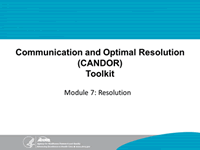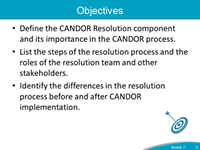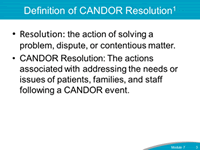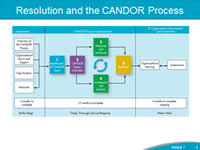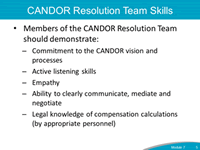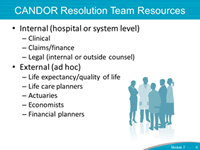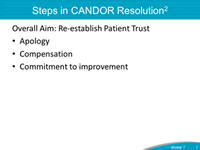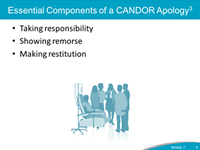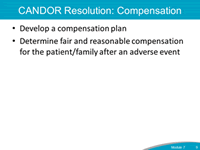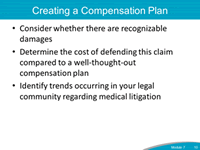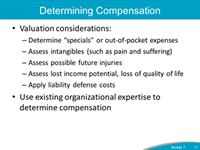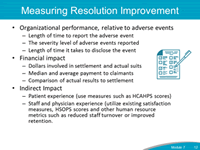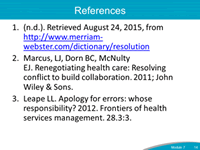Module 7: Resolution
AHRQ Communication and Optimal Resolution Toolkit
Facilitator Notes
| Say:
Module 7 of the CANDOR Toolkit describes the resolution phase of the CANDOR process. |
Slide 1
|
| Say:
When adverse patient events occur, the patient and their family are looking for answers to the basic who, what, where, when, and ultimately, why questions. A well developed resolution process, as defined in the CANDOR process, can help provide answers to the patient and family, as well as staff. This module will help an organization understand key resolution concepts and their relationship to adverse events. The objectives of this module are to:
|
Slide 2
|
|
Say: Resolution is defined as the action of solving a problem, dispute, or contentious matter. Resolution in the CANDOR process involves actions associated with addressing the patient, family, and staff expectations. The main objective of resolution in the CANDOR process is to meet the needs and expectations of the patient. Not doing this can lead to a loss of trust from the patient. This component of the overall process can lead to a financial settlement, but might not always lead to resolution of all issues related to the adverse event. Following patient harm events, the patient and/or family might sue the caregiver and/or organization, especially if a "deny and defend" approach is taken. However, litigation is not always a patient’s or family’s first instinct after an adverse event, so it is important to recognize the importance of disclosure and resolution in addressing unresolved needs or issues to prevent litigation and identify opportunities for improvement. |
Slide 3
|
| Say:
Resolution is a key component of the CANDOR process. It is not a one-time occurrence and can be revisited throughout the CANDOR process. Resolution addresses the needs and concerns of patients after an adverse event. Patients want to hear from their care providers and/or the organization an explanation of what happened and a heartfelt and sincere apology for the adverse event. Patients want to know what will be done to prevent the event from happening again. The patient and/or family might also want to participate in this process so other patients won’t be harmed. The key activities of the Resolution team include:
More information on supporting staff and creating a learning organization will be presented in the remaining modules. |
Slide 4
|
| Say:
It is important that clinical practitioners, risk management/claims, and financial and legal personnel have the same understanding and approach to the resolution of an adverse event. The organization should establish a CANDOR resolution team that supports this collaboration to work together to re-establish trust with the patient. The resolution team should have a commitment to the CANDOR process and vision, and have knowledge and experience in the following:
|
Slide 5
|
| Say:
A resolution team in a CANDOR process environment needs access to a variety of both internal and external resources. For the internal organizational resources, clinical, claims/finance, and legal personnel must be coordinated and integrated. This coordination ensures that all are working with the same goal and approach in resolving the CANDOR event. The external resources are typically external consultants who serve as ad hoc members of the core team, who can help assess some of the intangibles. Typically, this ad hoc group consists of experts in:
|
Slide 6
|
| Say:
The steps in the Resolution component are focused on re-establishing trust with the patient and/or family. The steps to reestablish trust with the patient and/or family include an apology, compensation, and a show of organizational commitment to improvement. In the CANDOR process, open and transparent communication with patients and families supports the patient’s and/or family’s need for an explanation of the patient harm event. Some organizations choose to involve patients/families in some manner in the event analysis process. By doing so, the organization can demonstrate its commitment to making sure steps are taken to prevent a similar event from occurring in the future. Patients and family members, just like clinicians and other staff, have a desire to ensure that other patients and families do not experience similar harm events. Not every adverse event deserves compensation, and not every patient or family wants financial compensation. However, patients and/or families frequently want to feel they are part of the improvement process. Assuming this role can help them regain trust in their care providers and the organization. |
Slide 7
|
| Say:
The first step of the Resolution component is to apologize for the adverse event. This apology is a regretful acknowledgement of the event by the care provider and/or the organization. The purpose for this apology is to begin to re-establish trust with the patient and the patient’s family. A CANDOR event apology should consist of the following components:
|
Slide 8
|
| Say:
Although compensation is not appropriate in every resolution of an adverse event, organizations should develop a compensation plan as part of the CANDOR process. Determining whether or not a patient/family will be compensated after an adverse event is the individual organization’s decision. A multidisciplinary team should convene to make decisions about compensation and often includes representatives from finance, clinical, quality/patient safety/risk, and administration. The CANDOR process supports a culture of safety, where the resolution process attempts to control the conversation by creating and managing expectations with internal and external groups. This is accomplished by the resolution team. |
Slide 9
|
| Say:
When implementing the CANDOR process, the organization should consider the following factors when developing the compensation plan:
These factors should be considered when analyzing the strengths and weaknesses of a case should it ultimately proceed to litigation. The malpractice climate is different in each State, so organizations should be knowledgeable of the issues within their communities. |
Slide 10
|
| Say:
When determining compensation for an adverse event, many aspects of compensation should be considered, including those that are not necessarily obvious. Valuation is a methodical approach that considers many of those aspects:
Where appropriate, experts in life expectancy, a life care planner, economist, actuaries, and financial planners can help the organization understand other potential factors that should be considered when developing the compensation package after an adverse event. |
Slide 11
|
| Say:
A number of metrics can compare organizational performance both before and after the CANDOR process has been implemented to demonstrate improvement. These metrics include organizational performance relative to adverse events, financial impact, as well as other indirect impact measures, which could include other areas for improvement in patient safety and quality. Use the Building the Business Case for CANDOR worksheet for more information on performance metrics. |
Slide 12
|
| Say:
A culture of safety requires open and ongoing communication with both internal and external groups to demonstrate the organization’s vision and interest in collaborating with key stakeholders to sustain the resolution process. Staff who need to participate, coordinate, and align among internal groups include:
The external groups with which the organization should continue to engage in the process include:
The Resolution component of the CANDOR process will take time. Resolution of an event presents an opportunity for organizational learning and sustainment of change, which will be discussed in Module 8 of the CANDOR Toolkit. |
Slide 13
|
| Slide 14
|




